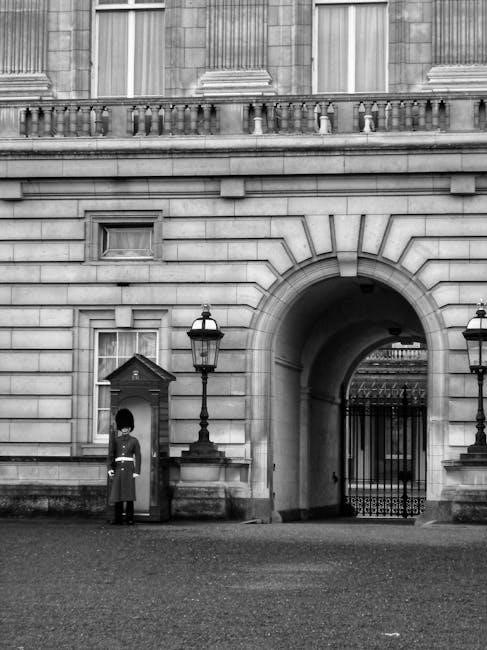Welcome to the ultimate guide on clipper guards! These essential tools are designed to help you achieve precise, even haircuts with ease․ Learn how to use them effectively․
1․1 What Are Clipper Guards?
Clipper guards are attachable combs that fit over the blades of hair clippers, guiding hair evenly toward the blades․ They determine the length of the cut, ensuring consistency․ Available in various sizes, they help achieve precise haircuts, from short trims to longer styles․ Essential for both professionals and home users, they simplify the hair-cutting process and prevent uneven results or accidental cuts․
1․2 Importance of Using Clipper Guards
Clipper guards are crucial for achieving consistent and precise haircuts․ They guide hair evenly toward the blades, ensuring uniform length and preventing uneven cuts or accidental nicks․ Guards protect the scalp from direct blade contact, making them safer to use․ They also simplify the process, allowing both professionals and home users to maintain consistent styles effortlessly, enhancing overall results and safety․

How Clipper Guards Work
Clipper guards attach to the blades, controlling hair length by guiding it evenly․ They ensure precise cuts and protect the scalp from direct blade contact, enhancing safety and accuracy․
2․1 Mechanism of Clipper Guards
Clipper guards function by attaching to the blade, controlling hair length precisely․ Their teeth comb through hair, guiding it evenly towards the blade․ This mechanism ensures uniform cutting, preventing unevenness․ Guards are designed with specific measurements, allowing for consistent results․ They also protect the scalp from direct blade contact, making the cutting process safer and more efficient overall․ Proper alignment is key for optimal performance and desired outcomes․
2․2 Types of Clipper Guards
Clipper guards come in various types, each designed for specific cutting needs․ Standard guards offer fixed lengths, while adjustable guards allow for multiple settings․ Fade guards create seamless transitions, and thinning guards reduce bulk․ Each type ensures precise control, catering to different hairstyles and preferences․ Understanding these variations helps in selecting the right tool for achieving desired results effortlessly and efficiently every time․ Explore their unique features to enhance your trimming experience․

Choosing the Right Clipper Guard Size
Selecting the appropriate clipper guard size is crucial for achieving your desired haircut․ Start by considering your hair length and the style you want․ Use a smaller guard for shorter cuts and a larger one for longer hair․ Match the guard size to your hair thickness and face shape for a balanced look․ This step ensures a precise and even trim, making your grooming process efficient and effective․
3․1 Understanding Guard Sizes and Hair Length
Guard sizes directly correlate with hair length, ensuring precise cuts․ A smaller guard, like a #1, trims hair shorter, while larger guards, such as #8, leave more length․ Understanding this relationship helps achieve consistent results․ Match the guard to your hair length needs, ensuring an even trim․ Proper alignment and angle of the clippers further enhance accuracy, making the haircut process seamless and professional․
3․2 Selecting the Appropriate Guard for Your Hairstyle
Selecting the right guard size is crucial for achieving your desired hairstyle․ Match the guard to your hair type and style goals․ For shorter styles, use smaller guards, while longer styles require larger ones․ Consider starting with a lower guard number for undercuts or fades, then blending with higher guards for a seamless finish․ This ensures a polished, professional-looking haircut tailored to your preferences․

Attaching Clipper Guards to Your Clippers
Attach the guard by aligning it with the clipper blade and sliding it on until it clicks․ Ensure a secure fit for precise, even hair cutting results․
4․1 Step-by-Step Guide to Attaching Guards
To attach a clipper guard, start by selecting the appropriate size for your desired haircut․ Align the guard with the clipper blade, ensuring it fits securely․ Gently slide the guard onto the blade until you hear a distinct click, indicating it is properly locked in place․ This ensures stability and even cutting․ Always refer to your clipper’s manual for specific attachment instructions, as models may vary․ Proper attachment is crucial for achieving consistent results and preventing accidental detachment during use․ Once attached, double-check the alignment to ensure the guard is evenly positioned and ready for cutting․ This step-by-step process ensures a safe and effective haircutting experience․ By following these simple steps, you can confidently use clipper guards to achieve professional-looking haircuts at home․ Remember, a secure fit is essential for optimal performance and safety․ After attaching, test the clippers on a small section of hair to ensure the guard is working correctly․ If the guard feels loose, remove it and reattach following the manufacturer’s guidelines․ Properly attached guards minimize the risk of uneven cuts and potential accidents, making your haircutting process smoother and more efficient․ Additionally, using the correct technique when attaching guards ensures longevity of both the clippers and the guards themselves․ Always handle the clippers and guards with care, as improper attachment can lead to damage or injury․ By mastering this step, you can enjoy precise control over your haircuts and experiment with various styles confidently․ Attaching guards correctly is the foundation of achieving the desired results, so take the time to ensure a snug and even fit every time․ This attention to detail will enhance your overall haircutting experience and contribute to better-looking outcomes․ Whether you’re a professional or a DIY enthusiast, proper guard attachment is key to success․ So, always prioritize this crucial step in your haircutting routine for the best results․
4․2 Ensuring Proper Fit and Alignment
Proper fit and alignment of clipper guards are crucial for safe and effective cutting․ Always hold the clippers at a slight angle to the scalp and move them in the opposite direction of hair growth for an even cut․ Start at the nape or behind the ear, with the guard’s top against the scalp․ Ensure the guard is securely attached and aligned with the blade to prevent uneven cuts and accidents․ Misalignment can lead to poor results or injury, so double-check the fit before cutting․ Proper alignment ensures consistent hair length and a professional finish․ Always maintain this technique for optimal safety and performance․
Using Clipper Guards for Different Hairstyles
Clipper guards enable precise control over hair length and style․ Use them to achieve even cuts, fades, or undercuts․ Key techniques include working against hair growth and maintaining proper angles for desired results․
5․1 Techniques for Even Cutting
To achieve even cuts, hold clippers at a slight angle, moving against hair growth․ Use consistent pressure and ensure guards are securely attached․ Start at the sides or nape, working methodically․ Check guard alignment and use a mirror for visibility, especially around ears and neck․ This ensures uniform length and a polished finish․
5․2 Achieving Specific Styles with Guards
Clipper guards are versatile tools for achieving precise hairstyles․ Use lower-numbered guards for shorter styles and higher numbers for longer cuts․ For fades, start with a smaller guard and graduate to larger ones․ To create undercuts, use guards to maintain length on top while trimming the sides and back evenly․ Experiment with angles and guard sizes to craft unique, personalized looks effortlessly․

Maintenance and Care of Clipper Guards
Regularly clean and sanitize clipper guards to prevent dirt buildup․ Store them properly in a dry place to avoid damage and ensure longevity of your tools․
6․1 Cleaning and Sanitizing Guards
Cleaning and sanitizing clipper guards is crucial for hygiene and maintenance․ Use a soft brush to remove hair clippings․ Soak guards in warm, soapy water to dissolve oils․ Sanitize with alcohol or disinfectant wipes․ Rinse and dry thoroughly to prevent rust․ Regular cleaning ensures optimal performance and extends the life of your clipper guards․
6․2 Storing Guards Properly
Store clipper guards in a protective case or pouch to prevent damage․ Keep them in a dry place to avoid rust and corrosion․ Organize guards by size for easy access․ Avoid stacking heavy objects on top of the storage container․ Proper storage ensures guards remain in good condition and ready for use when needed․

Troubleshooting Common Issues
Address uneven cuts by checking guard alignment and blade sharpness․ Adjust guard sizes for desired results and ensure proper fit to avoid poor outcomes during use․
7․1 Dealing with Uneven Cuts
Uneven cuts often result from improper guard alignment or dull blades․ Ensure the clipper is held at the correct angle and the guard is securely attached․ If issues persist, check blade sharpness and guard fit; Using the right technique, such as cutting against hair growth, can also help achieve a more even result;
7․2 Adjusting Guard Sizes for Desired Results
Adjusting guard sizes is key to achieving the desired haircut length․ Start with a lower guard for shorter styles and switch to higher guards for longer lengths․ Ensure the clipper is held at the right angle and moved against hair growth․ If unsure, consult a size guide to match your hairstyle needs perfectly․
Advanced Techniques with Clipper Guards
Master advanced techniques like fades and undercuts using clipper guards․ Experiment with curved blades for smoother transitions and layering․ Adjust guard sizes for seamless blends and precise cuts, ensuring professional-level results every time․ Regularly maintain your tools for optimal performance in creating intricate designs and styles․
8․1 Using Guards for Fade Haircuts
Clipper guards are essential for creating smooth fades․ Start with a lower guard size at the base and gradually increase as you move upward․ Use a slight angle to blend the lengths seamlessly․ For a natural fade, work in small sections, ensuring even pressure․ Tilt the clippers slightly to achieve a sharp, defined edge․ Practice makes perfect for mastering this technique․
8․2 Incorporating Guards into Undercuts
Clipper guards are ideal for undercuts, allowing precise control over the length of the undercut․ Start by selecting a shorter guard for the lower section and a longer one for blending․ Use the guard’s edge to create a seamless transition between lengths․ Work from the nape or behind the ears, ensuring even cuts․ This technique enhances definition and contrast in modern hairstyles, offering a sleek, polished look․

Pros and Cons of Using Clipper Guards
Clipper guards offer precision and consistent results but require proper fitting and maintenance․ They save time but may lack the versatility of freehand cutting techniques․
9․1 Benefits of Clipper Guards
Clipper guards provide consistent results by evenly guiding hair to the blades, ensuring uniform lengths․ They save time and effort, especially for beginners, reducing the risk of uneven cuts․ Guards also protect the scalp from direct blade contact, enhancing safety․ Their versatility allows for various hairstyles, from fades to undercuts, making them indispensable tools for both professionals and home users․
9․2 Limitations of Clipper Guards
Despite their benefits, clipper guards have limitations․ They can be bulky, making intricate designs difficult․ Half or quarter guards may confuse users, and improper alignment leads to uneven cuts․ Additionally, guards may not work well with very curly or thick hair, requiring extra effort․ Regular maintenance is needed to ensure optimal performance and longevity․

Clipper Guards vs․ Freehand Cutting
Clipper guards ensure consistent cuts and control hair length, while freehand cutting offers creativity and precision for detailed styles․ Guards are ideal for beginners, whereas freehand requires skill․
10․1 Comparing Techniques and Results
Clipper guards provide consistent, even cuts and are ideal for maintaining uniform hair length, making them perfect for beginners and routine trims․ Freehand cutting offers more creativity and precision, allowing for detailed styling and personalized results․ Guards reduce errors and ensure symmetry, while freehand requires skill and practice to achieve professional-looking fades and intricate designs․ Each method caters to different needs and skill levels․
10․2 When to Use Each Method
Clipper guards are ideal for maintaining even hair lengths and minimizing errors, making them perfect for home use or routine trims․ Freehand cutting is better suited for advanced techniques, intricate designs, and personalized styles․ Use guards for consistency and ease, and freehand for creativity and precision, depending on your skill level and desired outcome․
Clipper Guard Sizes for Different Face Shapes
Clipper guard sizes are chosen based on face shape to complement proportions․ Round faces use shorter guards for elongation, while oval faces are more versatile․ Square faces benefit from medium lengths, and triangular faces balance with longer guards to create a balanced look․
11․1 Choosing Guards for Round Faces
For round faces, shorter clipper guards (e․g․, #1 to #4) are ideal as they create a lengthening effect․ This helps slim the appearance of the face․ Use these guards to maintain balance and avoid adding volume, which can accentuate roundness․ Cutting against the grain or using fades can further enhance the desired elongation for a more defined look․
11․2 Selecting Guards for Oval, Square, and Triangular Faces
Oval faces can use most guard sizes, but mid-length guards (e․g․, #4 to #6) complement their natural symmetry․ For square faces, slightly longer guards (e․g․, #5 to #7) around the temples and jawline soften angular features․ Triangular faces benefit from shorter guards on the sides and back to balance width, creating a more proportional look while maintaining a neat, polished style․

Clipper Guards for Specific Hair Types
Clipper guards are tailored for different hair types, ensuring precise cuts․ Fine hair benefits from smaller guards, while thick or curly hair requires larger sizes for even results
12․1 Guards for Thin or Fine Hair
For thin or fine hair, smaller clipper guards are ideal as they provide a closer cut without causing excessive stress․ Using guards with shorter lengths helps achieve a neater appearance while maintaining natural hair movement․ This prevents the hair from looking too bulky or uneven, ensuring a more balanced and polished look․ Guards designed for fine hair also help prevent split ends and breakage, making them a must-have for precise styling․
12․2 Guards for Thick or Curly Hair
For thick or curly hair, larger clipper guards are recommended to manage volume and texture effectively․ Guards with longer lengths, such as size 4 or 6, are ideal as they allow for even cutting without clogging the blades․ This helps prevent unevenness and ensures a smoother finish․ Using the right guard size for curly hair also minimizes frizz and enhances natural texture, making styling easier and more efficient․
Clipper Guard Accessories and Attachments
Clipper guards come with various accessories, including additional combs and attachments, to enhance functionality․ These extras provide versatility for different hairstyles and ensure consistent results․
13․1 Additional Combs and Attachments
Additional combs and attachments expand your clipper’s versatility․ These include adjustable combs, tapering guides, and precision tips․ They allow for various styles, from fades to undercuts, ensuring precise control and consistency․ Accessories like these enhance your ability to achieve professional-looking results at home, making them indispensable for any grooming kit․
13․2 Enhancing Your Clipper Kit with Guards
Enhance your clipper kit by investing in high-quality guards that offer versatility and precision․ These attachments allow you to achieve various hairstyles effortlessly․ From fades to undercuts, guards provide consistent results․ They also protect the blades and ensure even cutting, making them an essential addition to your grooming tools for professional-level outcomes at home․

Clipper Guard Safety Tips
Clipper guards ensure safe and precise haircuts․ Always handle them with care to avoid accidents․ Store guards properly to prevent injuries and maintain their effectiveness over time․
14․1 Avoiding Accidents While Using Guards
Prevent accidents by handling clipper guards with care․ Ensure they are securely attached to clippers before use․ Avoid touching sharp blades and keep guards away from children․ Always cut in the direction of hair growth to prevent pulling or irritation․ Proper techniques and attention reduce risks, ensuring safe and effective haircuts every time․
14․2 Safe Storage to Prevent Injury
Store clipper guards in protective cases or pouches to prevent damage and injuries․ Keep them in a secure, dry location out of children’s reach․ Sanitize guards before storage to maintain hygiene and prevent germ spread․ Organize them neatly to avoid accidental contact and ensure they remain in good condition․ Proper storage enhances safety and preserves the quality of your clipper guards․
Clipper Guard Maintenance Tips
Regularly clean clipper guards with a soft brush and sanitize them with alcohol․ Store them dry to prevent rust and ensure longevity․ Lubricate moving parts for smooth operation․
15․1 Regular Maintenance for Optimal Performance
Regular maintenance is crucial for clipper guards․ Clean them with a soft brush to remove hair clippings and sanitize using alcohol․ Store guards in a dry place to prevent rust and ensure they remain in good condition; Lubricate any moving parts to keep the guards functioning smoothly and extend their lifespan․ Consistent care ensures precise cuts and durability․
15․2 When to Replace Worn-Out Guards
Replace clipper guards when they show signs of wear, such as rust, bent teeth, or uneven edges․ Worn guards can lead to uneven cuts and poor performance․ Check for damage regularly and replace them promptly to maintain precision and hygiene․ Timely replacement ensures consistent results and extends the life of your clippers, keeping your tools in optimal condition for every use․
Mastery of clipper guards ensures precise, consistent results․ Regular maintenance and proper use elevate your haircutting skills, helping you achieve any style with confidence and ease․
16․1 Summary of Key Points
Clipper guards are essential for achieving precise, even haircuts․ They guide hair evenly toward blades, ensuring consistent lengths․ Proper attachment, angle, and maintenance are crucial for optimal performance․ Guards come in various sizes to suit different hairstyles and face shapes․ Troubleshooting issues like uneven cuts involves adjusting guard sizes or techniques․ Regular cleaning and storage extend their lifespan, ensuring durability and reliability for future use․
16․2 Final Thoughts on Using Clipper Guards
Mastering clipper guards unlocks precise control over your hairstyles․ By choosing the right sizes and techniques, you can achieve professional-quality cuts at home․ Regular maintenance ensures longevity, while proper usage enhances safety․ Whether for fades, undercuts, or uniform trims, clipper guards are indispensable tools for anyone aiming for polished, consistent results․ Embrace their versatility to elevate your grooming routine effortlessly․
